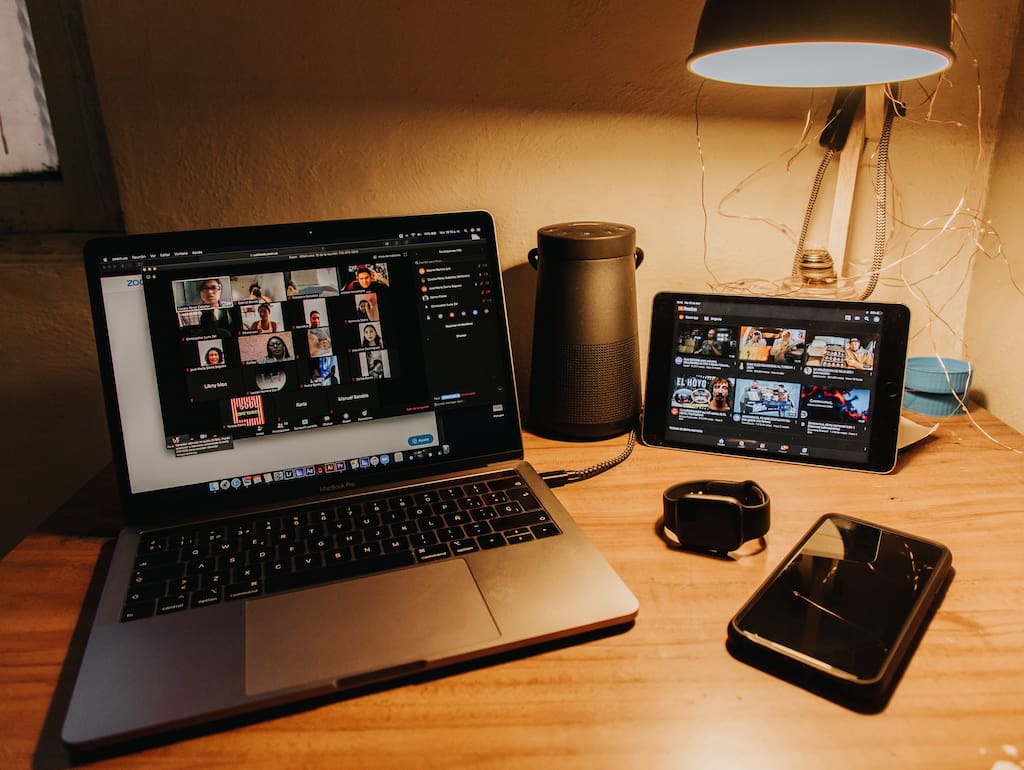Some believe that a virtual meeting is not the same as an actual meeting, so it’s okay to forego any meeting etiquette that applies in “real life”. This is a very misguided assumption. As long as we’re working, business etiquette rules apply.
The rules in communicating with a colleague or a client don’t change from halfway across the world. Below is an in-depth discussion of the proper virtual meeting etiquette, along with the best time tracking software to ensure that you never have to find yourself in an uncomfortable situation!
Virtual Meeting Etiquette Rules to Remember
1. Dress Professionally for Every Meeting
One of the benefits of working from home is that you can wear anything to work. That’s the dream, right? Still, it’s inappropriate to show your pajamas to your coworkers unless your company has specified otherwise.

Take the time to put on clean and professional-looking clothes. Don’t forget to brush your teeth and comb your hair. Make it a point to look professional from the waist up; no one will notice that you’re wearing shorts as long as you look clean on the screen!
2. Ensure Equipment and Connection are Working
One of the biggest nightmares of anyone attending a virtual meeting is getting cut off due to slow internet connections, broken equipment, or poor sound quality. These can interrupt all-hands meetings, and may frustrate your team or your client. The whole point of conducting a virtual meeting is to be able to see and listen to each other clearly despite the virtual space, and these issues are the antitheses of that.
Pro tip: If you are sharing a screen, make sure to hide sensitive information that the rest of your meeting should not see. Test your screen beforehand and check to see if you are only showing information relevant to the meeting. Close unnecessary browsers and documents to avoid any mishaps.
3. Choose the right software
Choosing the right software for you and your team goes a long way in increasing productivity and collaboration during meetings. The software you pick must be simple enough to use that anyone, even the most technologically challenged among you, can easily hop onto the call. User-friendly applications limit the chances of confusion, especially for those who are new to using the software.
4. Take note of your surroundings
It’s hard to take you seriously when there’s a pile of unwashed dishes on your desk. Whether you have a home office or not, you need to make it look like you have at least a dedicated workspace.
Make a conscious effort to remove any distractions and present a clean background. Having a neat desk setup gives off an organized vibe which speaks volumes about your professionalism. Also, removing distractions can help to keep your attention on the meeting.
Here are some tips to improve your background and limit distractions:
- Choose a room with a clean background wall and good lighting
- Test your camera’s view before the meeting begins
- Close the door to the room that you are in, ensure as much sound isolation as you can get
- Ask someone to take care of your dependents for the duration of the meeting
- Turn off your phone, television, or any device that can pose as a distraction
- Use a headset to minimize background noise

Although you should do as much as you can, there will always be a few unavoidable distractions. It’s best to inform your team members about them when you start your video meeting. They will appreciate the heads-up and might be completely understanding, considering that they may be experiencing similar things.
5. Arrive early
Whether in person or online, it’s a big no-no to arrive late for an appointment. Make an effort to arrive early, and use the time to get ready, troubleshoot problems, or recheck your presentation to avoid any errors.
6. Mute yourself unless you’re talking
Enable your mute option before starting the meeting. This reduces background noise and interruptions when someone is speaking. You can unmute yourself when it is your time to speak or when it’s required that you do so.
7. Keep your hands off the keyboard
There’s nothing wrong with taking down notes. However, the sound of typing can be very distracting for everyone. It might seem old school, but jotting down notes by hand can be an option to consider.

8. Look at the camera and speak clearly
When it’s your turn to speak, look directly at the camera (not at yourself or your coworkers on the screen) and speak clearly. Don’t look away or mumble, as it’s distracting and your message might not come across as well.
9. Give your full attention
It can be tempting to check your phone or flip through your documents during a particularly boring stretch but refrain from doing so. There’s a chance that you may miss out on key information, and more than that it’s just downright rude. Since it’s a virtual meeting, use attentive body language to show the speaker that you are listening.
10. Set goals and agendas
Just like in a regular meeting, a virtual meeting can go off-track when there are no goals or a clear meeting agenda. Create one and send it to all the attendees a few days before the start of the meeting. This way, they can communicate other topics they may want to include.

For example, the team wants to talk about Amazon management or Amazon SEO. These two topics are very broad, and can easily take up most of the time allotted. Having a set of subtopics and goals to discuss beforehand helps the flow of the meeting, and can limit the chances of it being diverted to other topics.
11. Introduce each member of the team
When you’re meeting with a new client or someone from another department, it’s best to introduce the person to the team and vice versa. This helps everyone in the meeting know who the person they are talking to is, and can facilitate in asking the right questions.
12. Assign a role for everyone
Have you ever entered a meeting where you had no clue of what you were supposed to do? If you have, then you know that it can definitely affect your team’s productivity and engagement.
Before you start a meeting, assign roles for each person. Nothing helps your meeting flow better than full clarity with regards to who should (and should not) be leading the meeting. Sharing a meeting agenda with the participants beforehand (specifying the topics to be discussed and who is to lead each conversation) helps tremendously.
13. Don’t interrupt
Whenever a person is speaking on the other end, don’t interrupt them. Take into account that there may be some delays due to the nature of online connections, so wait for a second or two after someone finishes speaking to say your piece.
14. Summarize the meeting
Before ending the meeting, summarize all the important topics discussed. To successfully achieve your goals, everyone should be able to understand the objectives set during the meeting.

15. Allow people to leave early
Let people leave the meeting early, especially those who just need quick updates. This is a more productive way to work and allows people to work on more important tasks instead of staying in a meeting where they aren’t needed.
16. Keep track of time
As much as possible, try and end on time. Assign someone to keep the meeting on track, and stay on the discussion points. This avoids the chances of wasting time and dragging the meeting on longer than is necessary.
17. Plan breaks for lengthy meetings
There are times when the meeting can take hours to meet objectives. Plan ahead and make appropriate arrangements such as quick breaks in between. This helps everyone avoid information overload.
One great idea for a break is to introduce a few ice breakers to the meeting. These can also be used to introduce the team to one another, and are effective when trying to keep the mood light and casual.
Virtual Meeting Etiquette: Ice Breaker Questions

Ice breakers are a great way to get acquainted with your team. They help build trust, confidence in speaking, and comradery. Here are a few ice breakers that you can use for your next virtual meeting:
🤝 “Getting to know you” ice breakers
- What did you eat for breakfast?
- Do you prefer tea or coffee?
- Are you a morning person or a night owl?
- Where did you grow up?
- What was your favorite childhood movie?
- What is one item you can’t live without?
- What’s the last great TV show or movie you watched?
- What’s the best book you’ve ever read?
- What new skills do you want to learn?
- What is your exercise routine?
🏡 “Work from home” ice breakers
- How long have you worked from home?
- Do you love working from home, or would you rather be in the office?
- What’s the hardest part about working from home?
- What is the easiest part of working from home?
- What’s your favorite work snack?
- Do you prefer to start early or work late?
- Do you have a home office? If not, where do you work at home?
- Show us your home office space!
- What is a unique thing you have within reach of your desk?
😂 Funny ice breakers
- What is your favorite emoji?
- What was the worst haircut you’ve ever had?
- Who was your childhood actor/actress crush?
- What’s the most embarrassing thing you’ve ever done?
- If you had to eat one meal every day for the rest of your life, what would it be?
- What unusual or quirky things do you do regularly?
- What’s your unusual talent?
Virtual Meeting Etiquette: Final Thoughts
Virtual meetings are becoming more and more common due to the events of the pandemic. Although it’s a drastic change for many company operations, it’s brought about benefits for businesses all over the world. It’s a wonderful tool for professional communication and remote collaboration and should be treated as such.
No matter how easy it is to slip into bad habits while working from home, virtual meetings are still a part of the office. Keep in mind that virtual business etiquette and code of conduct are extremely important for your professional life, so brush up by thoroughly reading our guide, stick to the group norms, and avoid embarrassing misunderstandings and mistakes in your next virtual work meeting!
If you are managing a team of 5 or more and looking to boost efficiency, Everhour is the perfect tool to keep your team on track. With seamless time tracking, you can easily estimate task durations, set clear budgets, and generate detailed reports inside Asana, Trello, Jira, or any other pm tool.

